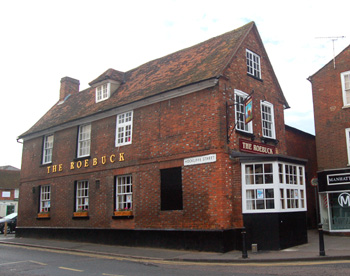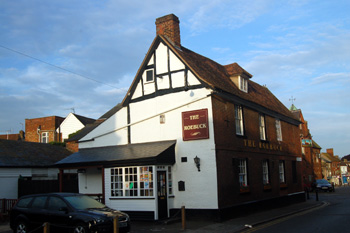The Roebuck Public House Leighton Buzzard

The Roebuck June 2008
The Roebuck Public House: 2 Hockliffe Street, Leighton Buzzard [earlier the White Horse]
The Manor of Leighton Buzzard alias Grovebury was the principal landowner in the town before the 19th century. Bedfordshire & Luton Archives & Records Service has a full run of court rolls from 1393 to 1727 [KK619-715] and another full run from 1704 to 1867 [X288/1-23]. The service also has court rolls for other manor to own land in the town, the Prebendal Manor, from 1448 to 1459, 1588 to 1591, 1611 to 1622, 1627 and 1631 [KK792-1798]. Detailed study of these would be bound to produce quite full histories for most licensed premises in the town. Unfortunately such study would take a very long time. Thus the histories of licensed premises in these web pages are quite summary and not necessarily the full story.
The Roebuck was listed by the former Department of Environment in 1974 as Grade II, of special interest. It was determined that the building dated from the early 18th century. It is built of brick in Flemish bond with red stretchers and grey headers; it has an old tile roof, two storeys with attics.
The first mention of the inn, however, is in 1696 when Martha Peacock, widow of John Marshe, conditionally surrendered the malthouse and kiln adjoining the White Horse [Z1118/1/6/1] and in 1709 John Peacock, who owned the Peacock in Lake Street, was admitted to the White Horse [X288/1], immediately surrendering it by way of mortgage to Anne Peacock. He surrendered it for good in 1711, along with the Peacock, to Mark Fountaine [X288/1].
In 1960 Bedfordshire Historical Records Society published a volume, its fortieth, dedicated to diaries. County Archivist Joyce Godber edited and published the diary of Leighton Buzzard Justice of the Peace John Salusbury (1713-1787) written between the years 1757 and 1759. There is one mention of the Roebuck in these three years, when he dined here with his club, the Civil Society, on 9th February 1758 "Mr. Capon's nomination". Incidentally this is the first mention of the inn by the name of Roebuck.
Bedfordshire & Luton Archives & Records Service has a formulary and notebook kept by 18th century attorney Benjamin Pyne which contains a list of twelve licensed properties in the town in 1761. Each inn also has a name beside it which appears to be the name of the licensee (who may both, of course, also have been the owner in some cases). The Roebuck is linked with the name of Richard Atkins, who seems also to have been the owner.
In 1774 Joseph Atkins was admitted to a cottage "heretofore called the White Horse now divided into three dwellings now one of them called the Roebuck" on the surrender of Ann, widow of William Weekes [X288/8]. Clearly, then, the White Horse had been a larger premises, perhaps extending further up Hockliffe Street. Atkins surrendered the inn to the uses of his will in 1780 [Z1118/1/21/12] and in 1871 his son-in-law William Drage was admitted [X288/8], surrendering it in 1788 to Ampthill brewer John Morris [Z1118/1/21/12].
In the Northampton Mercury of 19th January 1793 licensee of the Roebuck, Edward Walker, subscribed to a resolution of Leighton Buzzard publicans banning "seditious and disaffected persons" from their houses. This presumably was in reaction to the events across the Channel in France (four days previously King Louis XVI had been sentenced to death and two days later he went to the guillotine).
In 1813 John Morris surrendered the Roebuck to Samuel Reeve [Z1118/1/21/12] who was admitted in 1817 [Z1118/1/21/1]. Reeve made his will in 1821 devising all his real estate to trustees for sale [Z1118/1/21/13]. the will was proved in 1844 at which time the Roebuck was valued at £1,000 with a rent of £44 per annum [Z1118/1/21/16]. In 1845 Mary and Charles Reeve covenanted to surrender the copyhold elements of the Roebuck to Joseph Procter who had purchased Reeve's brewery and public houses [Z1118/1/21/18]. Procter immediately released the brewery and houses back to Reeve [Z1118/1/21/20]. The Roebuck was insured for £550 in 1846 [Z1118/1/21/30].
In 1864 Procter leased the brewery and licensed houses to Aylesbury [Buckinghamshire] brewer Edward Terry [Z1118/1/21/36]. The Roebuck was described as: "Roebuck public house, Leighton Buzzard, abutting Jeffs or Gig Lane being a brick built corner house with adjoining cottage south and communicating it, pebbled yard with cart entrance at the side containing a two stalled stable with loft over, a three bayed, slated cart shed with pump therein and timber built and thatched slaughterhouse; on the other side of yard and abutting on the lane a timber built and thatched coach house with a loft over and stabling for eight horses".
Two years later Joseph Procter was dead and his executors conveyed the brewery and licensed houses to James Procter [Z1118/1/21/38]. By the time of the countywide register of licensed premises of 1876 the owner was Percy Procter, who leased brewery and premises to Ashdown Brothers. In 1882 Procter again leased the brewery and premises to Levi and Richard Gibson Ashdown [Z1118/1/21/43]. On Procter's death brewery and licensed houses were conveyed to Hugh Procter, Harold Procter, John Goldsmith Procter and Jane Procter [Z1118/1/21/45]. In 1891 the Ashdowns were still leasing the brewery and licensed houses from Procter. In 1897 Hugh, Harold, John Goldsmith and Jane Procter conveyed brewery and licensed house to Kingsbury (St.Albans) Brewery [Z1118/1/21/51]. Kingsbury was later taken over by Benskins Watford Brewery, which later became Ind Coope.
By 2013 the Roebuck had closed and was boarded up.

The Roebuck seen from Hockliffe Street June 2008
References:
- Z1118/1/6/1: conditional surrender of malthouse and kiln: 1696;
- X288/1: admission: 1709;
- X288/1: conditional surrender: 1709;
- X288/1: surrender: 1711;
- X288/1: surrender: 1711;
- X288/1: admission: 1711;
- X171/206: landlord mentioned: 1761;
- X288/8: admission: 1774;
- Z1118/1/21/12: recited surrender: 1780;
- X288/8: admission: 1781;
- Z1118/1/21/12: recited surrender: 1788;
- Northampton Mercury: resolution of Leighton Buzzard publicans banning "seditious and disaffected persons" from their houses: 19 Jan 1793;
- Z1118/1/21/12: recited surrender: 1813;
- Z1118/1/21/18: recited admission: 1817;
- Z1118/1/21/13: abstracted will of Samuel Reeve: 1821-1845;
- CLP13: Register of alehouse licences: 1822-1828;
- Z1118/1/21/5: admission of: 1844;
- Z1118/1/21/16: valued at £1,000 with rent £44 per annum: c.1845;
- Z1118/1/21/27: Land Tax of £1/8/- on Roebuck: 1845;
- Z1118/1/21/22: heriot attached to premises: 1845;
- Z1118/1/21/18: covenant to surrender: 1845;
- Z1118/1/21/20: lease: 1845;
- Z1118/1/21/21: admission: 1845;
- Z1118/1/21/30: insured for £550: 1846;
- PSLB4/1: Register of Alehouse Licences - Leighton Buzzard Petty Sessional Division: c.1860s-1949;
- PSLB4/3: Register of Alehouse Licences - Leighton Buzzard Petty Sessional Division: c.1860s-1956;
- Z1118/1/21/36: lease: 1864;
- Z1118/1/21/38: conveyance: 1866;
- BML10/42/25: auction sale held at Roebuck: 1867;
- BML10/30/4: auction sale held at Roebuck: 1867;
- Z1118/1/21/43: lease: 1882;
- Z1118/1/21/45: conveyance: 1884;
- Z1118/1/21/51: conveyance: 1897;
- HN1/20-1-3: position shown on annotated Ordnance Survey maps compiled for licensing purposes: early 20th century
- PSLB4/2: Register of Alehouse Licences - Leighton Buzzard Petty Sessional Division: 1922-1948
List of Licensees: note that this is not a complete list; entries in italics refer to licensees where either beginning or end, or both, dates are not known:
1761: Richard Atkins;
1774: Joseph Atkins;
1780: William Drage;
1793: Edward Walker;
1822: Benjamin Gartside;
1839: Elizabeth Gartside or Garside;
1850: John Garside;
1869: Mrs Ann Garside;
1877: Henry James Hopkins;
1897: Emma Hopkins;
1910: Arthur John Gibbins;
1921: Sarah Ann Gibbins;
1925: George Walduck;
1938: John James;
1962: Percy Raymond Rolls;
1967: Ernest Gibson;
1968: Gerard Booth;
1969: David Brown Taylor;
1971: Samuel Robert Symonds;
1971: John Patrick O’Donnell;
1975: Walter Richard Lamb;
1977: John Alfred Davies;
1986: William Davidson;
1987: John Michael Short